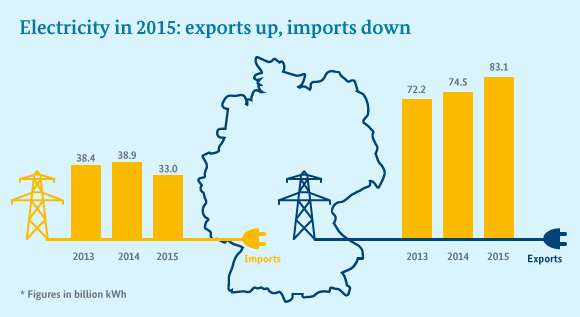Electricity – a leading export
Germany is exporting more and more electricity to its neighbouring countries. Cross-border trade in electricity contributes to security of supply and results in lower costs.
 © Federal Ministry for Economic Affairs and Energy; based on data from AGEB.
© Federal Ministry for Economic Affairs and Energy; based on data from AGEB.Trade in electricity: exports up, imports down
According to the provisional figures for 2015 published by the Working Group on Energy Balances (AGEB), Germany exported a total of 83.1 billion kilowatt-hours (kWh) to other countries. That is more than in the last two years, namely 74.5 billion kWh in 2014 and 72.2 billion kWh in 2013.
In the same period, electricity imports at 33 billion kWh fell to the lowest level in more than 20 years. They had amounted to 38.9 billion kWh in 2014 and 38.4 billion kWh in 2013.
More security of supply, lower costs
In 2015, Germany recorded an export surplus of around 50 billion kWh. The figures show that Germany's electricity exports to its neighbours were higher than its imports.
All people in the European Union benefit from cross-country trade in electricity since a larger, functioning market reduces costs. European electricity trading can take advantage of the smoothing effects over a wide area and efficiency gains in the fields of consumption, renewables and the use of conventional power plants. Consumers benefit from this in the form of lower electricity bills.
Connecting national energy systems also improves security of supply. If, due to a bottleneck, there is not enough electricity or gas available in one place, a well developed cross-border energy infrastructure can help to transport energy to wherever it is needed.
Lower energy consumption in Germany
The preliminary calculations also show that altogether Germany needs less energy. This becomes particularly evident when we look back on the last three years: in 2013, around 13,900 petajoules (PJ) were consumed in Germany. In 2014, consumption totalled only 13,200 PJ. Last year, consumption rose slightly at 13,300 PJ, but this was primarily due to the cold weather. One petajoule equals about 277.8 billion kWh. This corresponds, for instance, to the amount of energy that Saarland needs for its railway transport in the course of one year.
Germany has also set clear energy consumption goals for the coming years: These include the objective to cut the country's primary energy consumption by half by 2050 compared to 2008. The 20 per cent mark is to be reached by 2020.

